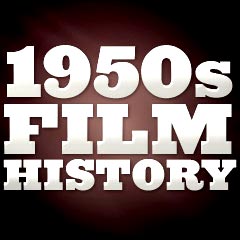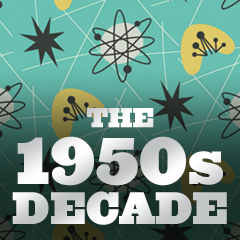|
Hitchcock in the 50s:
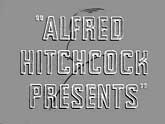 Britisher
Alfred Hitchcock (1899-1980), the "Master of Suspense," made
some of his very best suspense/thrillers during the 1950s, and also found
success in the new medium of TV in the mid-50s. He premiered his television
series anthology Alfred Hitchcock Presents in October, 1955, to
bring his macabre sense of humor to the small screen. Each show was prefaced
by his ominous, droll greeting "Good Evening" and short, introductory,
on-screen comments. Hitchcock employed most of his TV crew to produce
his black and white cinematic masterpiece at the end of the decade, the
low-budget Psycho (1960). Britisher
Alfred Hitchcock (1899-1980), the "Master of Suspense," made
some of his very best suspense/thrillers during the 1950s, and also found
success in the new medium of TV in the mid-50s. He premiered his television
series anthology Alfred Hitchcock Presents in October, 1955, to
bring his macabre sense of humor to the small screen. Each show was prefaced
by his ominous, droll greeting "Good Evening" and short, introductory,
on-screen comments. Hitchcock employed most of his TV crew to produce
his black and white cinematic masterpiece at the end of the decade, the
low-budget Psycho (1960).
Hitchcock became well-known and a noted film-maker for
two fundamental reasons: his clever cameos called attention to himself,
and his films often did well at the box-office. Although his late
1940s films, The Paradine Case (1947) and Under Capricorn
(1949)
(Hitchcock's second film in Technicolor) fared poorly, his 50s
films flourished:
- Under Capricorn (1949) - a
serious, historical melodrama set in 1830s Australia (with some similarities
to Hitchcock's earlier work, Rebecca (1940)) about a romantic
triangle between wealthy landowner and grim ex-convict murderer Sam
Flusky (Joseph Cotten), his mentally-unstable, reclusive, alcoholic
and fragile wife Lady Henrietta Flusky (Ingrid Bergman) (shunned
by Australian society and cared for by meddling and scheming housekeeper
Milly (Margaret Leighton)), and debonair Irishman Charles Adare
(Michael Wilding); eventually, the tragic reason for the Flusky's
move to Australia was revealed - Sam had been imprisoned when he
took the blame for Henrietta's killing of her brother, who was angered
over their elopement and marriage.
- Strangers on a Train
(1951) - adapted from Patricia
Highsmith's first novel about an amoral murderer who proposed a 'trade'
or 'exchange' of crimes; used as a springboard for director/star
Danny DeVito's satirical
Throw Momma From the Train (1987) with Billy Crystal
- the effective, voyeuristic suspenseful classic Rear
Window (1954) about a neighbor-spying photojournalist (James
Stewart) with a broken leg and his girlfriend (Grace Kelly) who believe
that one of his apartment dwellers may be a wife murderer
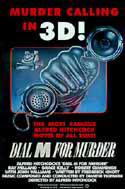 Dial
M for Murder (1954) - a murder thriller filmed in
3-D but not required to be shown that way, with Ray Milland
as an ex-tennis pro who masterminds to commit the "perfect" crime
- the murder of his unfaithful wealthy wife (Grace Kelly)
for having an affair with a TV mystery writer (Robert
Cummings) Dial
M for Murder (1954) - a murder thriller filmed in
3-D but not required to be shown that way, with Ray Milland
as an ex-tennis pro who masterminds to commit the "perfect" crime
- the murder of his unfaithful wealthy wife (Grace Kelly)
for having an affair with a TV mystery writer (Robert
Cummings) - The Man Who Knew Too Much (1955) - a remake
of Hitchcock's own 1934 film, with Doris Day looking for her kidnapped
son, and noted for the song "Que Sera Sera" as a key element
- The Trouble With Harry (1955)
- To Catch a Thief (1955)
- a lightweight stylish thriller filmed in the south of France,
and noted as being Grace Kelly's last film for Hitchcock, before
marrying Prince Rainier III of Monaco in mid-April 1956 and giving up
her film career forever; Kelly's last film was the Technicolor
musical comedy High Society (1956) with Cole Porter tunes, a
reworking of George Cukor's The Philadelphia
Story (1940); at the age of 52, in mid-September 1982, Princess
Grace suffered a stroke while driving on the same stretch of highway
in Monaco that she had driven in To Catch a Thief, and soon died
as a result of her injuries
- Vertigo (1958) - a tale
of masculine romantic obsession and disorientation (using a revolutionary
cinematographic technique of zooming out and tracking forward simultaneously
to visualize the 'vertigo' effect) for a retired San Francisco detective
(James Stewart), and with Kim Novak as a woman who 'returned' from the
dead
- the classic North by Northwest
(1959), exploring the director's favorite theme of an innocent
man (Manhattan businessman Cary Grant) caught in a complex series of
circumstances after being mistaken for a secret agent, and climaxing
at Mount Rushmore
New Directors in the 50s:
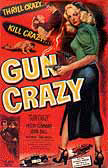 New
directors like Robert Aldrich made striking impressions with early films
like the apocalyptic Kiss Me Deadly (1955)
(an adaptation of a Mickey Spillane pulp with private eye Mike Hammer
(Ralph Meeker)). Stanley Kubrick directed the track heist thriller The
Killing (1956) and the anti-war drama Paths
of Glory (1957) with Kirk Douglas. Sidney Lumet's first
feature film was the brilliant jury-room drama 12
Angry Men (1957) with Henry Fonda standing along against conviction.
One of Joseph Lewis' best-known films was the noir, cult crime
film Gun Crazy (1949) - a forerunner of
Bonnie and Clyde (1967) and Natural
Born Killers (1994). Independent-minded Sam Fuller, director of hard-edged,
tabloid-ish films, led off the decade with the nasty, suspenseful thriller
Pickup on South Street (1953) about a pickpocket (Richard Widmark)
and a roll of top-secret Communist microfilm. New
directors like Robert Aldrich made striking impressions with early films
like the apocalyptic Kiss Me Deadly (1955)
(an adaptation of a Mickey Spillane pulp with private eye Mike Hammer
(Ralph Meeker)). Stanley Kubrick directed the track heist thriller The
Killing (1956) and the anti-war drama Paths
of Glory (1957) with Kirk Douglas. Sidney Lumet's first
feature film was the brilliant jury-room drama 12
Angry Men (1957) with Henry Fonda standing along against conviction.
One of Joseph Lewis' best-known films was the noir, cult crime
film Gun Crazy (1949) - a forerunner of
Bonnie and Clyde (1967) and Natural
Born Killers (1994). Independent-minded Sam Fuller, director of hard-edged,
tabloid-ish films, led off the decade with the nasty, suspenseful thriller
Pickup on South Street (1953) about a pickpocket (Richard Widmark)
and a roll of top-secret Communist microfilm.
Nicholas Ray:
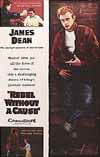 During
the post-war years, two directors who later achieved cult status emerged.
The first was one of the most original 50s directors - Nicholas Ray,
most famous for his best film Rebel Without
a Cause (1955). Ray also directed other interesting films
including a Bonnie-and-Clyde, lovers-on-the-run crime
film They
Live By Night (1949) -
(his first feature film), the murder mystery about a suspected homicidal
Hollywood screenwriter trying to begin a romance with his alibi-providing
neighbor in In
a Lonely Place (1950),
the noirish
On Dangerous Ground (1951), the quintessential rodeo film The
Lusty Men (1952), the bizarre cult Western Johnny Guitar
(1954),
Bigger Than Life (1956) with James Mason as a cortisone-addicted
schoolteacher, The True Story of Jesse James (1957) (a
re-make of the 1939 classic), and the crime drama Party
Girl (1958). During
the post-war years, two directors who later achieved cult status emerged.
The first was one of the most original 50s directors - Nicholas Ray,
most famous for his best film Rebel Without
a Cause (1955). Ray also directed other interesting films
including a Bonnie-and-Clyde, lovers-on-the-run crime
film They
Live By Night (1949) -
(his first feature film), the murder mystery about a suspected homicidal
Hollywood screenwriter trying to begin a romance with his alibi-providing
neighbor in In
a Lonely Place (1950),
the noirish
On Dangerous Ground (1951), the quintessential rodeo film The
Lusty Men (1952), the bizarre cult Western Johnny Guitar
(1954),
Bigger Than Life (1956) with James Mason as a cortisone-addicted
schoolteacher, The True Story of Jesse James (1957) (a
re-make of the 1939 classic), and the crime drama Party
Girl (1958).
Douglas Sirk:
The second talented and influential director of the 50s,
known for visually striking, feverish, highly polished, exaggerated, big
budget, emotional soap opera - melodramas,
was Douglas Sirk. His best-known glossy films, with innovative production
design and a dramatic use of garish color, often featured Rock Hudson:
-
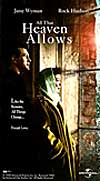 Magnificent Obsession (1954) - a remake of the successful 1935 blockbuster Magnificent Obsession (1954) - a remake of the successful 1935 blockbuster
- All That Heaven Allows (1955) - about a middle-aged
widow's unacceptable affair with her bohemian gardener in a small town
- the soapy Written on the Wind
(1956) about an alcoholic Texas oilman and his sexy, trampish
sister (Robert Stack and Oscar-winning Dorothy Malone)
- Interlude (1957)
- The Tarnished Angels (1957)
- A Time to Love and A Time to Die (1958)
- Imitation of Life (1959), Sirk's last film,
from the novel by Fannie Hurst
Declining Strength of the Studio System:
In the 1950's, the after-effects of the 1948 Paramount
Decrees (federal trust-busting laws that forbade studios to be linked
with theatre chains) were devastating. The courts ordered that the film
industry's vertically-integrated structure of production, distribution,
and exhibition had to be separated into distinct corporate entities, and
studios were ordered to sell off their theatres.
There were many other indications of the upheavals in
the film industry:
- once-powerful MGM mogul Louis B. Mayer resigned from
the studio in 1951 (to be replaced by producer Dore Schary, who was
fired in 1956) and died in 1957; MGM became an independent studio
in 1959
- Columbia Pictures established Screen Gems,
a subsidiary for making TV programs in 1951; it leased its pre-1948
films to television in 1955; and both founding rulers, the Cohn brothers,
died in the mid- to late-50s
- Darryl F. Zanuck resigned from 20th Century Fox
in 1956 to become an independent producer; as a result, the studio started
to lose money and was forced to sell its famous backlot and release
its post-1949 color films to NBC Television
- Universal International (formed in 1946 from
the merger of Universal Pictures and International Pictures) was sold
to Decca Records in 1952; it released its films to television in 1957
- Warner Bros. sold the film rights to its pre-1950
films to an investment group in 1956
- millionaire Howard Hughes, who had been in charge
of RKO Studios since 1948 and sole owner of the studio since
1954, sold off the studio's theatres (now a part of the Cineplex Odeon
group). By 1953, RKO Studios' losses totaled $20 million, and in 1954,
Hughes began the sell-off of the studio's film library to television,
and fired hundreds of employees. The studio was sold to the General
Tire and Rubber Corporation in 1955, and ceased the production of feature films
altogether in 1957. It announced plans to close and distribute/release its remaining pictures through other companies, primarily Universal-International. The studio that had made two of the greatest films ever, King Kong (1933) and Citizen Kane (1941) and was responsible for the cycle of Astaire-Rogers dance musicals, was no more
- Paramount sold the rights to its films (pre-1948)
to MCA in 1958
- film newsreels were discontinued in the mid-50s - they
were obvious victims of TV's reigning influence; the average US film
ticket price fell to $.51 in 1959 to compete with television
- the effects of nitrate-based film stock, discontinued
in the early 1950s because of its instability, began to be realized
with the gradual disintegration of many thousands of US films
The studios became depleted with the exit rush by both
directors, artists and technicians - mostly to the burgeoning television
industry. Some of Hollywood's greatest directors, George Stevens, John
Ford, and Leo McCarey, made half-hour dramas for the Screen Directors
Playhouse (1955) on television, and others (actors, editors, and cameramen)
followed suit. As a consequence, many of television's directors in the
50s, e.g., John Frankenheimer, George Roy Hill, Sidney Lumet, Sam Peckinpah,
Blake Edwards, Michael Ritchie, Robert Altman, Robert Mulligan, Arthur
Penn, and Franklin Schaffner became the new wave of the film industry's
directors into the 60s after the decline of the studio system.
The system of studio-contracted players (the star system)
began to lose some of its power and grip on movie stars in the early to
mid-50s as well, and the decline would steadily reach into the next decade.
Many of the stars went independent and operated as free-lance agents,
moving from studio to studio for individual pictures and ushering in the
age of the independent superstar. In the early 1950s, James Stewart decided
to free-lance, and became a precedent-setting pioneer of the percentage
deal, in which he would receive up to half the profits of his movies (he
received a share of the profits for the film Bend of the River (1952)).
Other stars followed suit and demanded payment on an individual film basis
(in single-film deals), beginning the trend toward huge star salaries
and the formation of their own production companies. Some superstars groomed
themselves and guided their own careers, appearing in their own starring
vehicles.
Directors charged that the demands of high-salary stars
would ruin the business. In fact, by 1959 the production of films in the
US dropped to about 250 films a year - a 50% drop from only a decade earlier,
and only 42 million Americans were attending theatrical films on a weekly
basis (as compared to more than double that amount during 1948). In contrast,
more and more imported European and Asian films (such as Rashomon (1950),
The Seven Samurai (1954), Pather Panchali (1955) and The
400 Blows (1959)) were being showcased in art houses and in burgeoning
film festivals.
The "Red Scare" and Various Propaganda Films:
The aftermath of studio blacklists and Communist Party
fears, following Senator Joseph McCarthy's HUAC witch-hunt that targeted
Hollywood and smeared hundreds of film people in the early 50s, had wide-spread
effects for years to come. Communist and "Cold War" paranoia
and fears of Communist infiltration were reflected in a number of films
of the early and mid-50s. Allegorical science
fiction films reflected the collective unconscious and often cynically
commented upon political powers, threats and evils that surrounded us
(alien forces were often a metaphor for Communism, e.g., Invasion
of the Body Snatchers (1956)), and the dangers of aliens taking
over our minds and territory.
Other examples of semi-exploitative, anti-communist films
helped to fuel the perceived threat of Communist spies and sympathizers,
and contributed to the propagandistic political temperament of the time:
- I Married a Communist (1949) (aka The Woman
on Pier 13), the first of several anti-Communist films made
by Howard Hughes at RKO
- Guilty of Treason (1950), a propagandistic docudrama
from director Felix E. Feist about courageous Hungarian Joszef Cardinal
Mindzhenty (Charles Bickford) who stood up to the Communist regime in
his native land and was imprisoned; the film included graphic scenes
of torture for those who resisted and were enemies of the State
- The Whip Hand (1951),
from director William Cameron Menzies, about a small town harboring
Communists who planned biological germ warfare by unleashing a deadly
virus
- Big Jim McLain (1952), from director Edward
Ludwig, a dreadful political thriller and message film featuring John
Wayne as an HUAC agent who pursued subversive pro-Reds in Hawaii; with
guest appearances from actual members of the committee
- The Hoaxters (1952), the sole Hollywood
film about communism presented as a documentary; the MGM film indicted
Fascists, Nazis, and Communists as damaging to the American way of life;
nominated as Best Documentary Feature (producer Dore Schary)
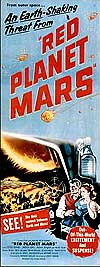 Invasion,
U.S.A. (1952), from director Alfred E. Green,
a low-budget sci-fi disaster film about a Russian nuclear attack on
the West Coast; Hedda Hopper exclaimed about the paranoid film, "It
will scare the pants off you!" Invasion,
U.S.A. (1952), from director Alfred E. Green,
a low-budget sci-fi disaster film about a Russian nuclear attack on
the West Coast; Hedda Hopper exclaimed about the paranoid film, "It
will scare the pants off you!"- My Son John (1952), an exaggerated anti-Communist
melodrama about a small-town couple who were shattered by the revelation
that their son (Robert Walker, who died before the film was completed)
was a Communist agent; nominated for Best Writing, Motion Picture Story
(Leo McCarey)
- Red Planet Mars (1952), one of the most notorious
and bizarre films during the period, from director Harry Horner, about
an embittered ex-Nazi scientist working for the Communists (intent on
destroying American democracy) by bouncing radio signals off the ionosphere
and making them appear to be coming from advanced extraterrestrials
on Mars, and then interpreted as being the voice of God
- Walk East on Beacon! (1952), a dramatic espionage
story (based on an article written by FBI head J. Edgar Hoover) about
a Boston-based Communist spy ring
- The 27th Day (1957), directed by William Asher,
about aliens who distributed boxes to five representatives of nations,
giving them the power to destroy the world
- Rocket Attack, USA (1961), an hysteria-producing,
alarmist, pseudo-documentary propagandistic film made during the early
years of the space race that contributed to fears of an inter-continental
ballistic missile (ICBM) attack by the Russians, and argued for a defense
system to protect the US from a nuclear launch; almost half the film
consisted of stock footage of the construction and test of American
ICBMs
- Red Nightmare (1962) (aka The Commies Are
Coming! The Commies Are Coming!), from director George Waggner,
an infamous propaganda short, narrated and hosted by Jack Webb, about
a nightmarish takeover of the US by Communist forces
The legacy of HUAC's blacklisting
was also felt in this decade by Best Screenplay nominee Michael Wilson
for Friendly Persuasion (1956), a Civil War tale about a Quaker
pacifist family (with actor Anthony Perkins' film debut). His nomination
for writing the film's screenplay (uncredited in the film) was declared
ineligible and his name was prohibited from a listing in the final awards
ballot, because of his invoking of the 5th Amendment before the committee
in 1952. Finally, by 1959, the Academy of Motion Picture Arts and Sciences
(AMPAS) determined that blacklisted film industry members could be
nominated for Oscar awards.
By the advent of the 60s, anti-Communist films took a
more satirical edge, evidenced in a backlash of black comedies and serio-comic
films, such as Billy Wilder's One, Two, Three (1961), The
Manchurian Candidate (1962), Kubrick's Dr.
Strangelove, Or:... (1964), and The Russians Are Coming, The
Russians Are Coming (1966). And they became bolder with other such
critical films as Otto Preminger's Advise and Consent (1962), Fail-Safe
(1964), and Seven Days in May (1964).
 Film History of the 1950s
Film History of the 1950s
Part 1, Part 2, Part 3, Part 4, Part 5, Part 6

 
|
